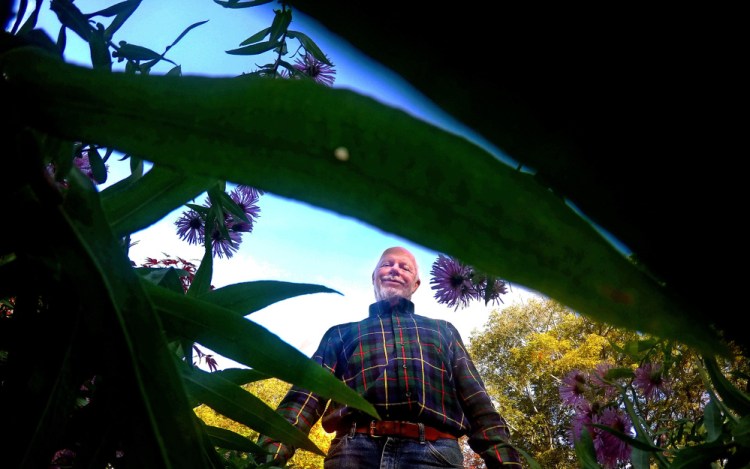The drought dominated this year’s garden season. It began with a light snowpack and below-average rain for every month except June. The rain in June didn’t do much good, though; it came mostly in one hard storm, so much of it ran off instead of soaking into the ground. September, when we normally get fall rains, was the driest of all.
My wife Nancy and I watered our entire garden property – vegetables, flower beds and lawns – four times. In addition, we hand-watered the newly planted blueberries and asparagus and most of the vegetables regularly, using water from the rain barrels as well as water we saved from the kitchen sink.
Watering added a lot of work – and time – in the garden.
But mostly it was a good year.
My prime goal this year was to grow carrots successfully – and I did. With the first two plantings – one in April and the second in May – I used pelletized Mokum seeds in our new cold frame. The pelletized seed prevented me from planting the seeds too close together, and the cold frame kept insects and other pests from eating the newly sprouted seeds.
We finished eating the last of those carrots about a week ago, and are now picking from an early July planting – with traditional seeds because I’d used up all the pelletized seed. We’ve a healthy-looking August planting coming along, too. Using the pelletized seed for the first two crops drove home how carefully I need to spread the seeds to get a good crop.
The drought and warm temperatures actually helped some vegetables. More of our sweet peppers ripened to a full red than ever before, and we still have a lot of green ones on the plants as of October 6, when I am writing this – with no immediate frost expected along the coast where we live. The tomatoes were plentiful until about a month ago – then they just stopped, even though we grew indeterminate varieties (the type that produce, or should produce, tomatoes until the frost comes). But we started picking in mid-July and for 10 weeks ate all the tomatoes we wanted. We still are harvesting some Sun Gold cherry tomatoes, which produced both the first and last tomatoes we had all year. They are a favorite, even though about a quarter of them split before they ripen fully.
The black beans did well. I planted both Coco Noir and Mitla. The Coco Noir I bought from Fedco two years ago and, after interviewing seed-saving guru Will Bonsall, saved enough beans so I could plant them again this year – which was good because they were not available from Fedco this year. The Mitla was back in the catalog after an absence of several years. For me, the Coco Noir produced better, but I am looking forward to doing a taste-test.
The blueberries and asparagus we planted in a new section are growing well. I let about 15 of the blueberries ripen on three of the 10 plants, and we should be able to pick a few more next year. I think I didn’t time the dormant oil and Bt spraying on the winter moth caterpillars well enough to get berries on the older plants (the moths eat the blooms and small leaves off the bushes before pollination takes place). When state entomologist Charlene Donahue spoke to the Cape Elizabeth Garden Club I learned that the dormant oil should be sprayed fairly late in winter and the Bt should wait until the first leaves come out on the blueberries. I’ll follow her instructions next spring, which should help our blueberry blooms last long enough to be pollinated.
The asparagus is standing tall and healthy. According to instructions, we didn’t harvest any this year. Next year, according to some sources, we should be able to harvest a couple of spears from each plant – and I probably will, but only if I see a second sprout beginning.
I know I still have to get through winter, but am already looking forward to eating asparagus daily from mid-May until the peas come in early July.
Our strawberries didn’t do as well as I would have liked, and it is only the third year on the bed, so I am fertilizing, weeding and mulching to bring the bed back. The raspberries were prolific and tasty.
Our back lawn is being taken over by violets (both white and purple), which I don’t mind. It’s the bare spots that bother me. A month ago I spread compost over the bare spots, seeded those sections and watered regularly. Some seed is sprouting already, but it isn’t as thick as I would like. I’ll see how it looks come spring and may seed again. I’m not looking for perfection, but would like to get rid of the naked spots. Maybe I just need to be patient and the violets will spread more.
Our flowers bloomed well, but because of the heat and drought the bloom time for many of them was shorter this year.
After setting up a small copper trellis made with leftover piping, I planted some nasturtiums that were supposed to climb. The flowers produced well, but declined to climb the trellis – instead they wandered through nearby hops, coreopsis and other plants. A nice cottage-garden effect but not really what I had in mind.
I think the drought was tough on the “Endless Summer” series of hydrangeas, but the PeeGee and Annabelle varieties were as reliably productive as ever – as were the daylilies.
So, as always, I enjoyed spending time in the garden. There were a few failures and more successes.
And it kept me thinking about things other than politics.
Tom Atwell is a freelance writer gardening in Cape Elizabeth. He can be contacted at 767-2297 or at: tomatwell@me.com.
Send questions/comments to the editors.


